warning light Citroen C5 2012 (RD/TD) / 2.G User Guide
[x] Cancel search | Manufacturer: CITROEN, Model Year: 2012, Model line: C5, Model: Citroen C5 2012 (RD/TD) / 2.GPages: 316, PDF Size: 9.75 MB
Page 119 of 316
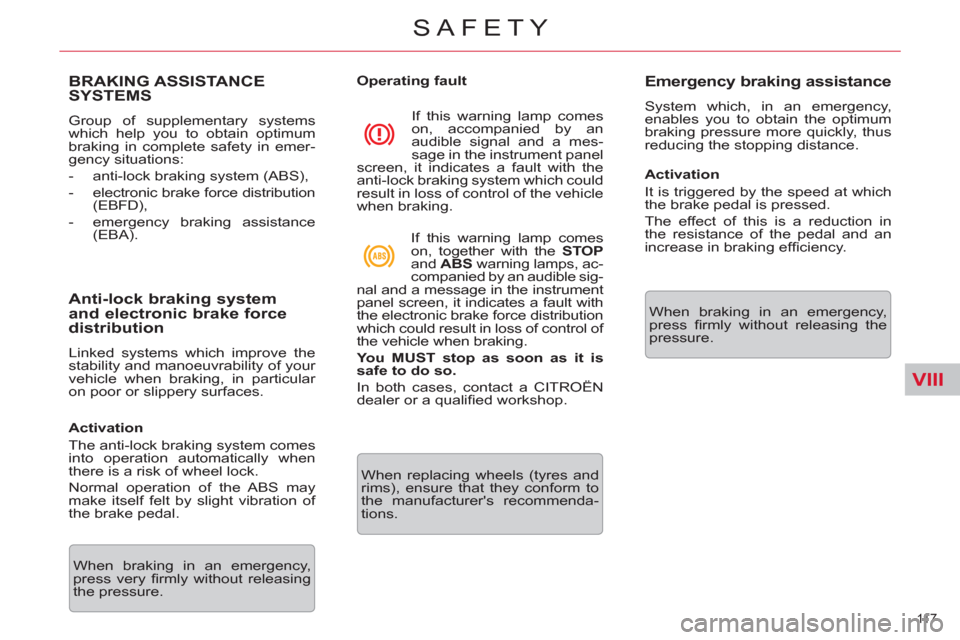
VIII
11 7
SAFETY
BRAKING ASSISTANCE
SYSTEMS
Group of supplementary systems
which help you to obtain optimum
braking in complete safety in emer-
gency situations:
- anti-lock braking system (ABS),
- electronic brake force distribution
(EBFD),
- emergency braking assistance
(EBA).
Anti-lock braking system
and electronic brake force
distribution
Linked systems which improve the
stability and manoeuvrability of your
vehicle when braking, in particular
on poor or slippery surfaces.
Activation
The anti-lock braking system comes
into operation automatically when
there is a risk of wheel lock.
Normal operation of the ABS may
make itself felt by slight vibration of
the brake pedal.
Operating fault
When braking in an emergency,
press very fi rmly without releasing
the pressure. If this warning lamp comes
on, accompanied by an
audible signal and a mes-
sage in the instrument panel
screen, it indicates a fault with the
anti-lock braking system which could
result in loss of control of the vehicle
when braking.
If this warning lamp comes
on, together with the STOP
and ABS
warning lamps, ac-
companied by an audible sig-
nal and a message in the instrument
panel screen, it indicates a fault with
the electronic brake force distribution
which could result in loss of control of
the vehicle when braking.
You MUST stop as soon as it is
safe to do so.
In both cases, contact a CITROËN
dealer or a qualifi ed workshop.
When replacing wheels (tyres and
rims), ensure that they conform to
the manufacturer's recommenda-
tions.
Emergency braking assistance
System which, in an emergency,
enables you to obtain the optimum
braking pressure more quickly, thus
reducing the stopping distance.
Activation
It is triggered by the speed at which
the brake pedal is pressed.
The effect of this is a reduction in
the resistance of the pedal and an
increase in braking effi ciency.
When braking in an emergency,
press fi rmly without releasing the
pressure.
Page 123 of 316

VIII
121
SAFETY
The driver must ensure that passen-
gers use the seat belts correctly and
that they are all restrained securely
before setting off.
Wherever you are seated in the ve-
hicle, always fasten your seat belt,
even for short journeys.
Do not interchange the seat belt
buckles as they will not fulfi l their
role fully.
The seat belts are fi tted with an in-
ertia reel permitting automatic ad-
justment of the length of the strap
to your size. The seat belt is stowed
automatically when not in use.
Before and after use, ensure that the
seat belt is reeled in correctly.
The lower part of the strap must be
positioned as low as possible on the
pelvis.
The upper part must be positioned
in the hollow of the shoulder.
The inertia reels are fi tted with an
automatic locking device which
comes into operation in the event
of a collision, emergency braking or
if the vehicle rolls over. You can re-
lease the device by pulling fi rmly on
the strap and releasing it so that it
reels in slightly. In order to be effective, a seat belt
must:
- be tightened as close to the body
as possible,
- be pulled in front of you with a
smooth movement, checking
that it does not twist,
-
be used to restrain only one person,
- not bear any trace of cuts or fraying,
- not be converted or modifi ed to
avoid affecting its performance.
Recommendations for children
Use a suitable child seat if the pas-
senger is less than 12 years old or
shorter than one and a half metres.
Never use the same seat belt to se-
cure more than one person.
Never allow a child to travel on your
lap.
In accordance with current safety
regulations, for all repairs on your ve-
hicle, go to a qualifi ed workshop with
the skills and equipment needed,
which a CITROËN dealer is able to
provide.
Have your seat belts checked regu-
larly by a CITROËN dealer or a
qualifi ed workshop, particularly if the
straps show signs of damage.
Clean the seat belt straps with soapy
water or a textile cleaning product,
sold by CITROËN dealers.
After folding or moving a seat or rear
bench seat, ensure that the seat belt
is positioned and reeled in correctly.
In the event of an impact
Depending on the nature and se-
riousness of the impact
, the pre-
tensioning device may be deployed
before and independently of the
airbags. Deployment of the preten-
sioners is accompanied by a slight
discharge of harmless smoke and
a noise, due to the activation of the
pyrotechnic cartridge incorporated
in the system.
In all cases, the airbag warning lamp
comes on.
Following an impact, have the seat
belts system checked, and if neces-
sary replaced, by a CITROËN dealer
or a qualifi ed workshop.
Page 132 of 316

IX
!
!
130
DRIVING
Dynamic emergency braking
In the event of a failure of the ve-
hicle’s main braking system or in
an exceptional situation (e.g. driver
taken ill, under instruction, etc) pull
and hold control lever A
to stop the
vehicle.
The electronic stability programme
(ESP) provides stability during dy-
namic emergency braking.
If there is a fault with the dynamic
emergency braking, one of the fol-
lowing messages will be displayed
in the instrument panel screen:
- "Parking brake faulty".
- "Parking brake control faulty". If a failure of the ESP sys-
tem is signalled by the light-
ing of this warning lamp,
then braking stability is not
guaranteed. In this event, stability
must be assured by the driver by
repeating alternate "pull release" ac-
tions on control lever A
.
The dynamic emergency brak-
ing should only be used in ex-
ceptional circumstances.
Emergency parking brake
release
In the event of the electric parking
brake failing to release, an emergen-
cy device can be used to release the
parking brake manually, provided that
it is possible to immobilise the vehicle
while the procedure is carried out.
�)
If you can start the vehicle: with
the engine running, immobilise
the vehicle by applying the foot
brake while the operation is be-
ing carried out.
�)
If you are unable to start the ve-
hicle (fl at battery for example):
do not use this device and con-
tact a CITROËN dealer or a
qualifi ed workshop. However, if
you are obliged to proceed, fi rst
immobilise your vehicle securely
and then follow the instructions
below. If the vehicle cannot be im-
mobilised, do not operate
the emergency release. Your ve-
hicle may run away if on a slope.
Contact a CITROËN dealer or a
qualifi ed workshop.
Page 143 of 316

IX!
141
DRIVING
STOP & START
The Stop & Start system puts the en-
gine temporarily into standby - STOP
mode - during stops in the traffi c
(red lights, traffi c jams, or other...).
The engine restarts automatically -
START mode - as soon as you want
to move off. The restart takes place
instantly, quickly and silently.
Perfect for urban use, the Stop &
Start system reduces fuel consump-
tion and exhaust emissions as well
as the noise level when stationary.
Operation
- with the electronic gearbox
system
, at speeds below 4 mph
(6 km/h), press the brake pedal or
put the gear lever in position N
.
Going into engine STOP mode
The "ECO"
warning lamp comes
on in the instrument panel and
the engine goes into standby:
If your vehicle is fi tted
with the system, a time
counter calculates the
sum of the periods in
STOP mode during a journey. It rests
itself to zero every time the ignition
is switched on with the key.
For your comfort, during parking
maoeuvres, STOP mode is not
available for a few seconds after
coming out of reverse gear.
STOP mode does not affect the func-
tionality of the vehicle, such as for ex-
ample, braking, power steering...
Never refuel with the engine
in STOP mode; you must
switch off the ignition with the
key.
Special cases: STOP mode not
available
In this case, the "ECO"
warning lamp fl ashes for a
few seconds then goes off.
This operation is perfectly normal.
STOP mode is not invoked when:
- the driver's door is open,
- the driver's seat belt is not fas-
tened,
- the vehicle has not exceeded
6 mph (10 km/h) since the last
engine start using the key,
- the electric parking brake is ap-
plied or being applied,
- the engine is needed to maintain
a comfortable temperature in the
passenger compartment,
- demisting is active,
- some special conditions (battery
charge, engine temperature,
braking assistance, ambient
temperature...) where the engine
is needed to assure control of a
system.
Page 194 of 316
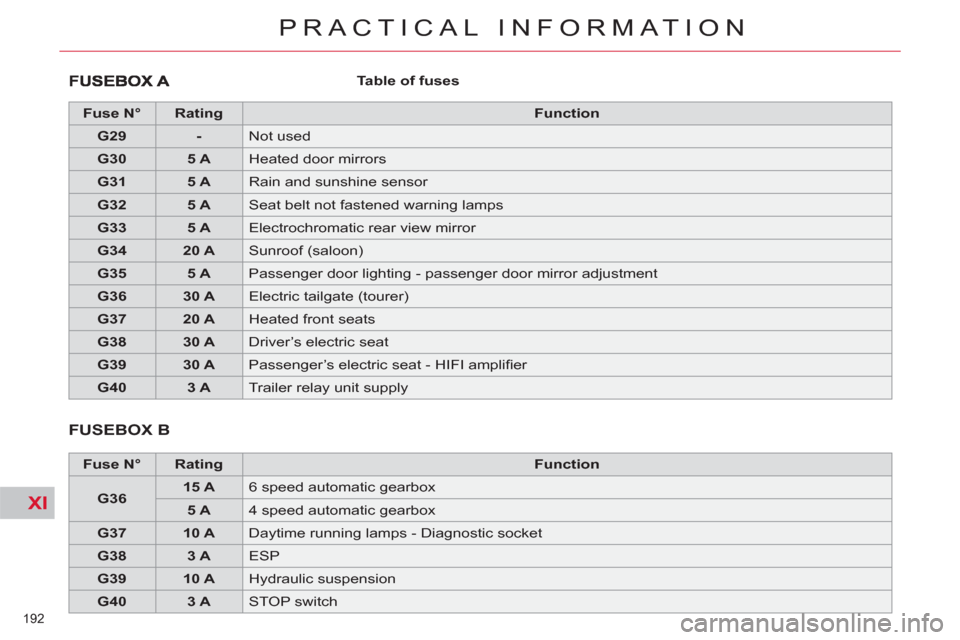
XI
192
PRACTICAL INFORMATION
Table of fuses
Fuse N°
Rating
Function
G29
-
Not used
G30
5 A
Heated door mirrors
G31
5 A
Rain and sunshine sensor
G32
5 A
Seat belt not fastened warning lamps
G33
5 A
Electrochromatic rear view mirror
G34
20 A
Sunroof (saloon)
G35
5 A
Passenger door lighting - passenger door mirror adjustment
G36
30 A
Electric tailgate (tourer)
G37
20 A
Heated front seats
G38
30 A
Driver’s electric seat
G39
30 A
Passenger’s electric seat - HIFI amplifi er
G40
3 A
Trailer relay unit supply
FUSEBOX B
Fuse N°
Rating
Function
G36
15 A
6 speed automatic gearbox
5 A
4 speed automatic gearbox
G37
10 A
Daytime running lamps - Diagnostic socket
G38
3 A
ESP
G39
10 A
Hydraulic suspension
G40
3 A
STOP switch
Page 195 of 316
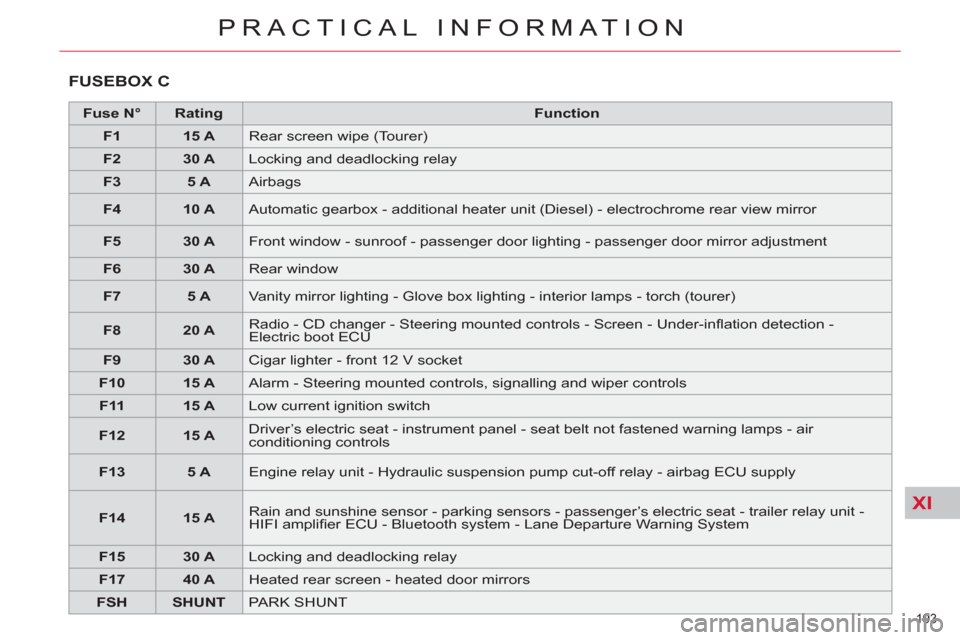
XI
193
PRACTICAL INFORMATION
FUSEBOX C
Fuse N°
Rating
Function
F1
15 A
Rear screen wipe (Tourer)
F2
30 A
Locking and deadlocking relay
F3
5 A
Airbags
F4
10 A
Automatic gearbox - additional heater unit (Diesel) - electrochrome rear view mirror
F5
30 A
Front window - sunroof - passenger door lighting - passenger door mirror adjustment
F6
30 A
Rear window
F7
5 A
Vanity mirror lighting - Glove box lighting - interior lamps - torch (tourer)
F8
20 A
Radio - CD changer - Steering mounted controls - Screen - Under-infl ation detection -
Electric boot ECU
F9
30 A
Cigar lighter - front 12 V socket
F10
15 A
Alarm - Steering mounted controls, signalling and wiper controls
F11
15 A
Low current ignition switch
F12
15 A
Driver’s electric seat - instrument panel - seat belt not fastened warning lamps - air
conditioning controls
F13
5 A
Engine relay unit - Hydraulic suspension pump cut-off relay - airbag ECU supply
F14
15 A
Rain and sunshine sensor - parking sensors - passenger’s electric seat - trailer relay unit -
HIFI amplifi er ECU - Bluetooth system - Lane Departure Warning System
F15
30 A
Locking and deadlocking relay
F17
40 A
Heated rear screen - heated door mirrors
FSH
SHUNT
PARK SHUNT
Page 202 of 316

XI!
200
PRACTICAL INFORMATION
TOWING A TRAILER
Towbar suitable for the attachment
of a trailer or installation of a bicycle
carrier, with additional lighting and
signalling.
Your vehicle is primarily designed
for transporting people and luggage,
but it may also be used for towing a
trailer.
If the towbar is not fi tted by a
CITROËN dealer, it is imperative
that it is fi tted in accordance with
the vehicle manufacturer's instructions.
Driving advice
Distribution of loads
�)
Distribute the load in the trailer
so that the heaviest items are as
close as possible to the axle and
the nose weight approaches the
maximum permitted without ex-
ceeding it.
Air density decreases with altitude,
thus reducing engine performance.
Above 1 000 metres, the maximum
towed load must be reduced by 10 %
for every 1 000 metres of altitude.
Side wind
�)
Take into account the increased
sensitivity to side wind.
Cooling
Towing a trailer on a slope increases
the temperature of the coolant.
As the fan is electrically controlled,
its cooling capacity is not dependent
on the engine speed.
�)
To lower the engine speed, re-
duce your speed. The maximum towed load on a long
incline depends on the gradient and
the ambient temperature.
In all cases, keep a check on the
coolant temperature.
Braking
Towing a trailer increases the brak-
ing distance.
To avoid overheating of the brakes
on a long mountain type of descent,
the use of engine braking is recom-
mended.
Tyres
�)
Check the tyre pressures of the
towing vehicle and of the trailer,
observing the recommended
pressures.
Lighting
�)
Check the electrical lighting and
signalling on the trailer.
The rear parking sensors will be
deactivated automatically if a gen-
uine CITROËN towbar is used.
�)
If the warning lamp and
the STOP
warning lamp
come on, stop the vehicle
and switch off the engine
as soon as possible.
We recommend the use of genuine
CITROËN towbars and their har-
nesses that have been tested and
approved from the design stage of
your vehicle, and that the fi tting of the
towbar is entrusted to a CITROËN
dealer or a qualifi ed workshop.
Driving with a trailer places great-
er demands on the towing vehicle
and the driver must take particular
care.
Refer to the "Technical Data" section
for details of the weights and towed
loads which apply to your vehicle.
Page 210 of 316
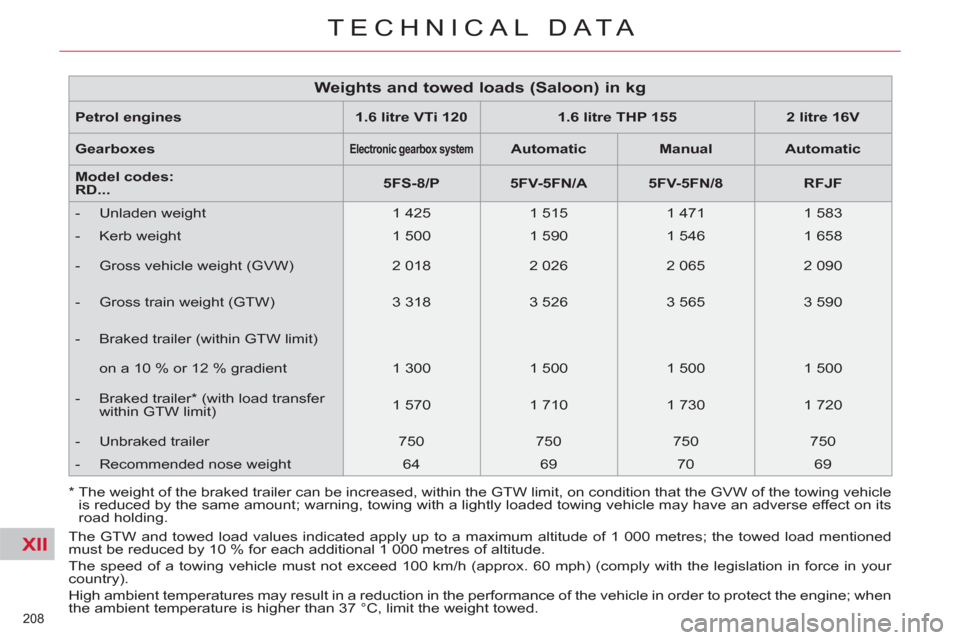
XII
208
TECHNICAL DATA
* The weight of the braked trailer can be increased, within the GTW limit, on condition that the GVW of the towing vehicle
is reduced by the same amount; warning, towing with a lightly loaded towing vehicle may have an adverse effect on its
road holding.
Weights and towed loads (Saloon) in kg
Petrol engines
1.6 litre VTi 120
1.6 litre THP 155
2 litre 16V
Gearboxes
Electronic gearbox system
Automatic
Manual
Automatic
Model codes:
RD...
5FS-8/P
5FV-5FN
/A
5FV-5FN/8
RFJF
- Unladen weight
1 425
1 515
1 471
1 583
- Kerb weight
1 500
1 590
1 546
1 658
- Gross vehicle weight (GVW)
2 018
2 026
2 065
2 090
- Gross train weight (GTW)
3 318
3 526
3 565
3 590
- Braked trailer (within GTW limit)
on a 10 % or 12 % gradient
1 300
1 500
1 500
1 500
- Braked trailer * (with load transfer
within GTW limit)
1 570
1 710
1 730
1 720
- Unbraked trailer
750
750
750
750
- Recommended nose weight
64
69
70
69
The GTW and towed load values indicated apply up to a maximum altitude of 1 000 metres; the towed load mentioned
must be reduced by 10 % for each additional 1 000 metres of altitude.
The speed of a towing vehicle must not exceed 100 km/h (approx. 60 mph) (comply with the legislation in force in your
country).
High ambient temperatures may result in a reduction in the performance of the vehicle in order to protect the engine; when
the ambient temperature is higher than 37 °C, limit the weight towed.
Page 211 of 316
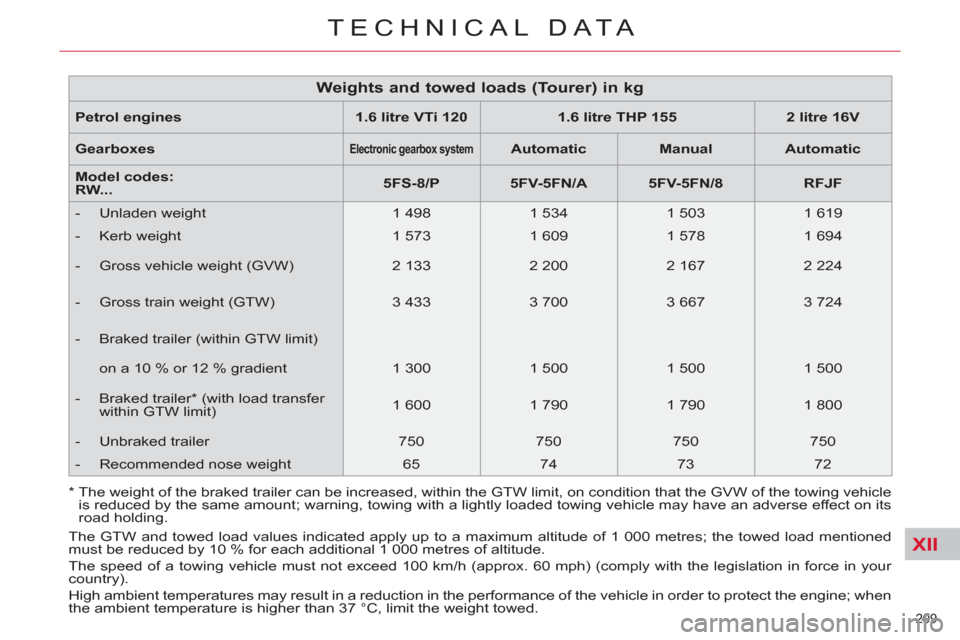
XII
209
TECHNICAL DATA
Petrol engines
1.6 litre VTi 120
1.6 litre THP 155
2 litre 16V
Gearboxes
Electronic gearbox system
Automatic
Manual
Automatic
Model codes:
RW...
5FS-8/P
5FV-5FN
/A
5FV-5FN/8
RFJF
- Unladen weight
1 498
1 534
1 503
1 619
- Kerb weight
1 573
1 609
1 578
1 694
- Gross vehicle weight (GVW)
2 133
2 200
2 167
2 224
- Gross train weight (GTW)
3 433
3 700
3 667
3 724
- Braked trailer (within GTW limit)
on a 10 % or 12 % gradient
1 300
1 500
1 500
1 500
- Braked trailer * (with load transfer
within GTW limit)
1 600
1 790
1 790
1 800
- Unbraked trailer
750
750
750
750
- Recommended nose weight
65
74
73
72
The GTW and towed load values indicated apply up to a maximum altitude of 1 000 metres; the towed load mentioned
must be reduced by 10 % for each additional 1 000 metres of altitude.
The speed of a towing vehicle must not exceed 100 km/h (approx. 60 mph) (comply with the legislation in force in your
country).
High ambient temperatures may result in a reduction in the performance of the vehicle in order to protect the engine; when
the ambient temperature is higher than 37 °C, limit the weight towed.
* The weight of the braked trailer can be increased, within the GTW limit, on condition that the GVW of the towing vehicle
is reduced by the same amount; warning, towing with a lightly loaded towing vehicle may have an adverse effect on its
road holding.
Weights and towed loads (Tourer) in kg
Page 214 of 316
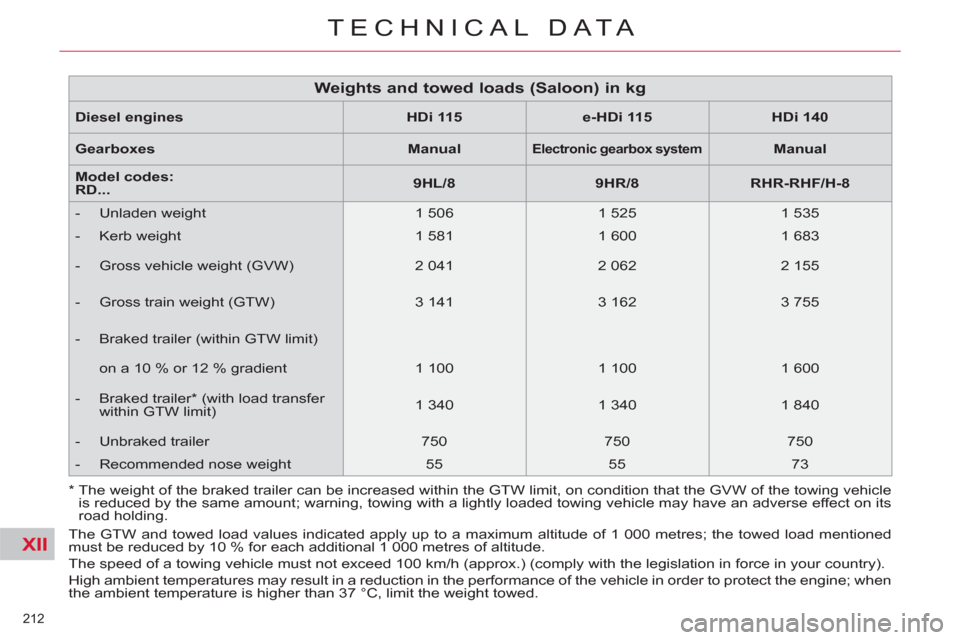
XII
212
TECHNICAL DATA
The GTW and towed load values indicated apply up to a maximum altitude of 1 000 metres; the towed load mentioned
must be reduced by 10 % for each additional 1 000 metres of altitude.
The speed of a towing vehicle must not exceed 100 km/h (approx.) (comply with the legislation in force in your country).
High ambient temperatures may result in a reduction in the performance of the vehicle in order to protect the engine; when
the ambient temperature is higher than 37 °C, limit the weight towed.
* The weight of the braked trailer can be increased within the GTW limit, on condition that the GVW of the towing vehicle
is reduced by the same amount; warning, towing with a lightly loaded towing vehicle may have an adverse effect on its
road holding.
Weights and towed loads (Saloon) in kg
Diesel engines
HDi 115
e-HDi 115
HDi 140
Gearboxes
Manual
Electronic gearbox system
Manual
Model codes:
RD...
9HL/8
9HR/8
RHR-RHF/H-8
- Unladen weight
1 506
1 525
1 535
- Kerb weight
1 581
1 600
1 683
- Gross vehicle weight (GVW)
2 041
2 062
2 155
- Gross train weight (GTW)
3 141
3 162
3 755
- Braked trailer (within GTW limit)
on a 10 % or 12 % gradient
1 100
1 100
1 600
- Braked trailer * (with load transfer
within GTW limit)
1 340
1 340
1 840
- Unbraked trailer
750
750
750
- Recommended nose weight
55
55
73